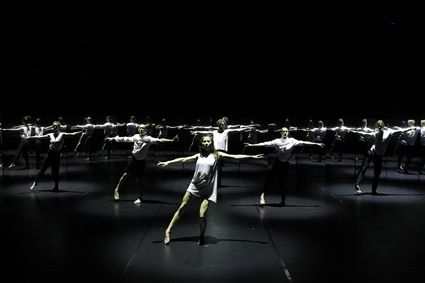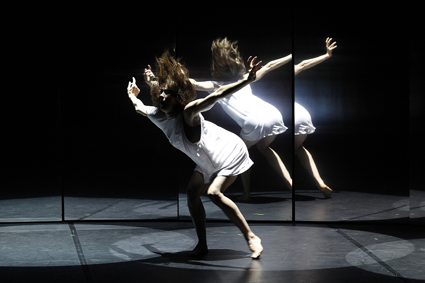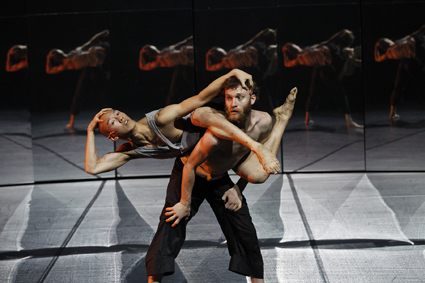inner fury, seductive skill
philipa rothfield: anouk van dijk, chunky move, 247 days

Tara Soh, James Pham, Lauren Langlois, Leif Helland, Niharika Senapati, Alya Manzart, 247 Days, Chunky Move
photo Jeff Busby
Tara Soh, James Pham, Lauren Langlois, Leif Helland, Niharika Senapati, Alya Manzart, 247 Days, Chunky Move
247 DAYS IS DARK: DARK THOUGHTS, DARK SPACE, A DARK VISION ALL ROUND. OSTENSIBLY ARISING OUT OF ANOUK VAN DIJK’S MOVE FROM EUROPE TO AUSTRALIA, 247 DAYS IS VERY MUCH CONCERNED WITH THE INNER WORLD OF ITS PERFORMERS, WHETHER REAL OR NOT. THE QUESTION OF THE REAL IS LESS IMPORTANT IN ANY CASE, FOR THIS IS A PSYCHOLOGICAL CONFABULATION.
The stage is dominated by a curved series of mirrors, a speculum of internal space. The work begins with an extended solo. A young woman (Lauren Langlois) contemplates her image intently, shifting weight, searching for reassurance which is structurally lacking, inasmuch as the mirror cannot compensate the anxieties which compel the search. Her own joints cannot offer support. She turns towards us, turns back, turns to us, turns back. This is an obsessive compulsion which finds relief neither in the image nor in the gaze of the other. The performer articulates her needs, her wants, her desires. Is she talking to us? I don’t think so.
This girl has no centre, she is hollow but for her anxieties. She runs then sets up a pattern of movements that the others join, each oriented towards their own image. The group is a set of splinters united in movement, divided by an atomistic mode of experience. There is nonetheless a certain pleasure in watching the group move together, gained through observing their collective mastery of space in time.

Lauren Langlois, 247 Days, Chunky Move
photo Jeff Busby
Lauren Langlois, 247 Days, Chunky Move
Their dancing is more sustained than their speech which is truncated: stuttered emotions garnered on the run and selected largely for their shadow side. These psychological bubbles are mirrored in momentary facial expressions, smiles more like the rictus of a corpse, a silent scream (reminiscent of Francis Bacon’s Screaming Pope series). The muscles of the face swish over bone.
The spine is distended at the edges, the big toe a distorted coda to a leg turned inwards. Lines of movement traverse the body, not for beauty’s sake. Happily, phylogeny takes over and lizard crawls allow for a pure moment of cross-lateral slithering. That clear passage from one diagonal to its corresponding other becomes a linear clarity through space. I begin to recognise a kind of style. The body is the site of linear flows, which may begin with a pelvis flung inwards, a step turning into a twist, the torque of the torso, the body dipping for a leg lift, whatever it takes to keep this line of movement going. The head and spine undulate towards their maximum curvature. The head has a relative independence from the spine, suggesting a giddying loss of control, belied by the underlying skill needed to let go of vision’s anchorage. In fact, a great deal of the dancing has these two sides of the coin: letting go of control/amazing control in letting go.
The solos give way to duets and a trio. Much of the duet work consists of one partner holding and spinning the other like a centrifuge, the motion outwards counter-balanced by an inward spiral. Then the two lean towards each other, sharing weight, seeking touch through pouring weight into the body of the other. Sometimes one person will lead the movement of another through the head. The poetics of these partnerships has to do with relationships, variously expressed in terms of love, control, loss of control, agency and helplessness. One couple hug and fling in turns.
The curved mirror is broken up and deconstructed to produce a proliferation of reflections, liminal spaces to be occupied by the dancers. Bit by bit the work unravels to reveal individual reflections.
Attempting to reflect on the tenor of 247 Days, I find myself oscillating between thinking of it as a dystopian construction and seeing it as a social reflection of the real. Perhaps all dystopias have their root in the historical present, taking their line of flight through some imaginary proposition: the apocalypse, totalitarian hegemony, cultural cannibalism, man’s inhumanity to man.

James Pham and Leif Helland, 247 Days, Chunky Move
photo Jeff Busby
James Pham and Leif Helland, 247 Days, Chunky Move
247 Days explores an experiential slice of life, youthful, anxious, fearful, not especially happy. Faces are discontinuous with inner feelings, the mirror a crucible of angst. By contrast, the choreography works on a somewhat different register. The physical prowess of the performers rarely mirrors their expressions of insecurity and doubt. A certain seduction of performative skill—that is, the audience is drawn into the dancing—belies the internal sound of fury that finds expression through voice and facial gesture. Maybe this difference offers an out to the tendency for 247 Days to totalise the negative. Am I being too negative?
See also our realtime tv video interview with choreographer Anouk van Dijk.
Dance Massive, Malthouse: Chunky Move, 247 Days, concept, choreography Anouk van Dijk, performers Leif Helland, Lauren Langlois, Alya Manzart, James Pham, Niharika Senapati, Tara Soh, composition, sound designer Marcel Wierck, set design Michael Hankin, lighting Niklas Pajanti, costumes Shio Otani; The Malthouse Theatre, March 15–23; http://dancemassive.com.au
RealTime issue #114 April-May 2013 pg. 28






